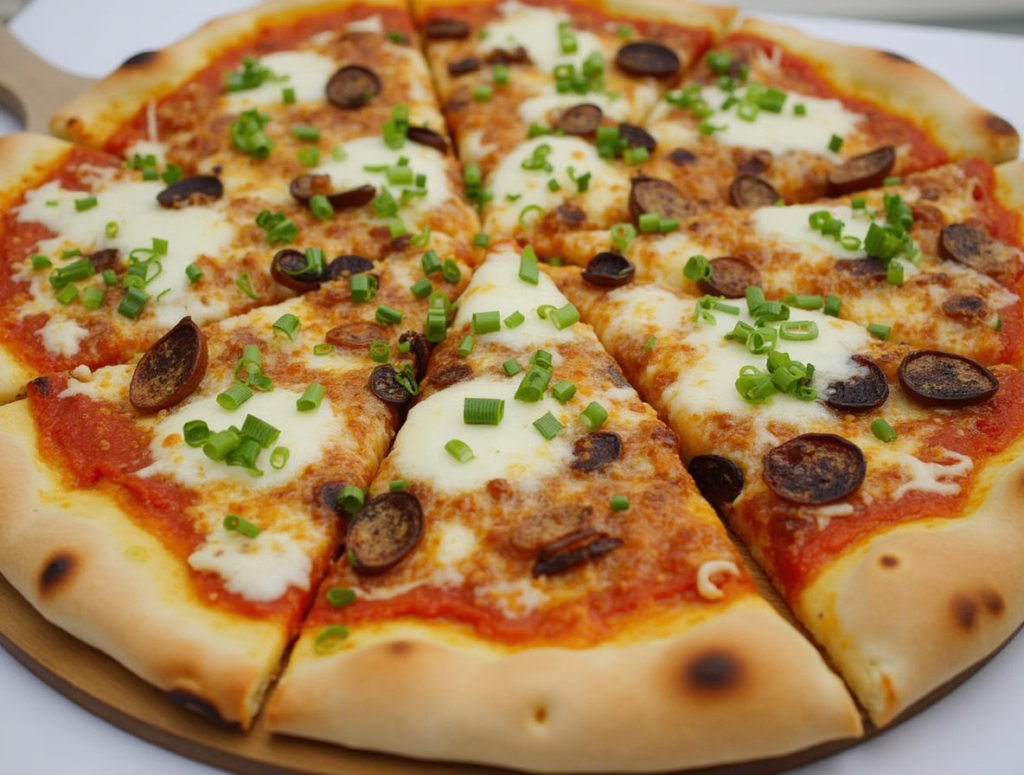Brooklyn-style pizza is a popular variation in New York’s rich pizza heritage. Known for its distinctive, thin, crispy-but foldable crust, minimal toppings, and local tradition and culture, Brooklyn style pizza emerged as a formal term nationally in 2006, thanks to the introduction of “Brooklyn style” pizza by Domino’s.
It is important to note that Brooklyn-style pizza is over a century old, dating back to the borough’s Italian immigrant communities.
Characteristics of Brooklyn Style Pizza
Thin, Crispy, and Foldable Crust: A defining characteristic of Brooklyn style pizza is the hand-stretched, thin crust, which is crisp on the bottom and foldable.
The combination of characteristics allows for eating while on the go, which is synonymous with daily life in New York.
Large, Wide Slices: Brooklyn pies are usually large – at least 18 inches – and then cut into big, foldable slices, often requiring two hands.
Reduced Toppings: Brooklyn-style pizza focuses on restraint. Unlike pizzas that are heavily loaded with toppings, Brooklyn-style pizza lightly uses toppings, enhancing the flavor and texture of the crust. Toppings are usually reduced to a simple tomato sauce and some melted mozzarella (and/or provolone). Brooklyn-style pizzas usually use mozzarella and provolone in a 45:55 ratio.
Distinctive Sauce: With a tangy and bright sauce that is not as sweet as other regional styles, the traditional application of the sauce is spread thin.
Coal or Gas Oven: Many old Brooklyn pizzerias still use coal ovens, which create a mild smokiness to the crust and a slightly crispier bottom. That said, gas ovens are now quite common.
Brooklyn Style vs. Other Pizza Styles
| Feature | Brooklyn-Style Pizza | Classic New York-Style Pizza | Chicago Deep Dish Pizza |
| Crust | Thinner, crispier, foldable | Thin, but slightly thicker/softer | Thick, buttery, pie-like |
| Slice Size | Very large, wide, foldable | Large, wide, foldable | Deep, often eaten with fork |
| Toppings | Minimal, light cheese and sauce | Moderate cheese and sauce | Heavy cheese, sauce on top |
| Oven Type | Often coal or gas | Coal or gas | Deep, oiled pan |
| Eating Style | Folded in half, on the go | Folded in half, on the go | Knife and fork |
A Brief History
Brooklyn style pizza is a product of Italian immigrants who came to New York in the late nineteenth and early twentieth centuries and adapted their traditional Neapolitan recipes to local tastes and ingredients.
Brooklyn’s pizzerias quickly became known for the crispier and stronger crust and a “less is more” approach to toppings by producing larger and thinner pies that could be sold by the slice.
The term “Brooklyn style pizza” has rarely been employed locally by the pizzeria owners until Domino’s Pizza popularized the term nationally in 2006.
In Brooklyn, pizza is simply pizza, but the term has started to represent an aesthetic: thin, crisp, foldable, and very basic.
How Many Slices Are in a Large Pizza?
Cultural Significance and Local Icons
Brooklyn’s pizza is as multi-dimensional as the borough itself, with legendary institutions such as Di Fara, Totonno’s, Lucali, and Roberta’s, each putting its spin on the basic formula.
These pizzerias are treasured for their pies and their status as neighborhood gathering places and community landmarks.
How to Make Brooklyn-Style Pizza at Home
A basic Brooklyn-style dough recipe includes:
- Bread flour (for chew and crispness)
- Water (some say New York tap water makes a difference)
- Yeast, salt, sugar, and olive oil
The dough ferments slowly for flavor enhancement before being stretched thin, covered with a simple tomato sauce, a mix of mozzarella and provolone, and baked at a high temperature for a short time.
Conclusion
Brooklyn-style pizza is a lot more than a regional style; it is an emblem of New York’s melting-pot culture, culinary inventiveness, and the public’s hunger for an excellent slice.
Its crispy, foldable crust, minimalist toppings, and rich history are a standard for other pizzas in New York—and increasingly across the country.



